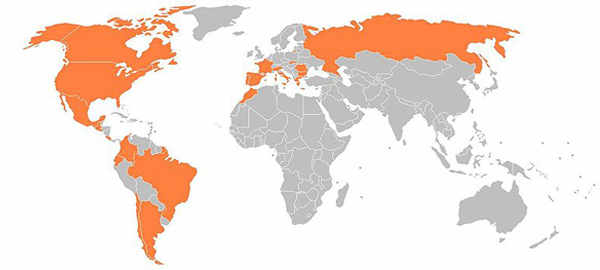Last week we introduced you to the procurement operations at Europe’s second largest utility company, Enel and its procurement executive in charge of the technology infrastructure and the company processes that are mapped to them, Mario Mosca, Enel’s Head of Procurement, Processes and Systems based in Rome (their global operations are shown in orange on the map above). In these two earlier articles which are found here and here (links), we introduced you to this 64 billion Euro revenue company’s approach to process automation and the technology infrastructure that supports its procurement operations. Today we will look at how Mario made the case for an investment in a Spend Analysis solution and the process that he followed to deploy the system.
At the outset of this second, two-part series, we would once again like to extend our extreme gratitude to Mario for the time spent preparing documents and being interviewed so that we could provide this exclusive, behind-the-scenes look to our readers. As a “friend of the site,” Mario hopes that CPOs and other procurement leaders (i.e. the readers of CPO Rising) who have not yet made a case for Spend Analysis will find this case presentation informative and useful as they begin to consider building their cases. That is our hope too.
Making a Case for Spend Analysis
As Mario approached the end of 2008, he began to put the finishing touches on the business case for an investment in a Spend Analysis solution for Enel. Since joining Enel earlier in the year, Mario had been steadily gathering and tracking the latest case studies and research on Spend Analysis to understand different approaches to and the best practices in achieving spend visibility.
From this exercise, what Mario had determined was that the best, if not only, way to optimize Enel’s spending on goods and services, was to possess detailed information about (1) the different categories of spend that it procured, (2) the types of contracts that are in place (3) the suppliers that provide the goods and services (4) pricing information on categories
The major challenge for Enel was where and how this important information was stored. Like most other companies, there were different sources of the information (invoices, orders, receipts, etc), the information resided in different systems (eg ERP, procurement, financial); and the information was stored in different formats.
Having laid out the very clear challenge that Enel faced, Mario began to leverage research to help understand and then present the value that the typical procurement department was seeing from an investment in an SA solution. (Sidebar: I was very pleased to see that the bulk of Mario’s business case was, in fact, based upon on research that I personally had conducted and written at my previous employer.)
I now quote Mario either quoting or paraphrasing some of the key findings in my research from late 2008 and early 2009 because (A) It is actually what Mario did and therefore, part of the story and (B) I believe that the findings presented here hold true today and could be leveraged by our readership.
“Spend Analysis can provide the necessary basis for procurement departments to make better sourcing decision.”
“Studies conducted by leading analysts in the world show that the adoption of programs for the control of expenditure (Spend Visibility) can bring to business, and benefits of process efficiency and organization, including a significant reduction in costs purchase, on the order of 12.7%. The need to guard systematically expenditure data shared by companies of all sectors, both public and private sectors. This can easily be achieved by adopting a structured Spend Analysis processes, supported by technology and dedicated expertise.”
By this point in the process, Mario had convincingly made the case – that Spend Analysis was a wholly worthwhile initiative. To bolster the case that a fully-automated solution was the best way to proceed, Mario again referencing my earlier research continued:
“The percentage level of potential savings achievable through the adoption of a spend analysis and process’ directly proportional to the level of automation…. So the investment is justified when the level of automation is ‘high. We must also consider the results and impact of a spend analysis process that is not automated.”
Mario felt strongly that “the automated analysis of Enel’s expenditures held significant benefit and returns and that a manual process that was generally non-repeatable and would require significant re-work for each cycle analysis.”
Mario’s case was made and gave promise to the following benefits:
- Greater bargaining power with suppliers
- Identification of spending consolidation opportunities
- Constant visibility of spend to show the number of contracted suppliers
- Understanding the expected demand for different categories based upon historical spend information
- Better overall understanding of the exposure Enel had with its different suppliers
We’ll be back next week for the conclusion of this case and our coverage of procurement operations at Enel. Our next article will appear on Tuesday.

